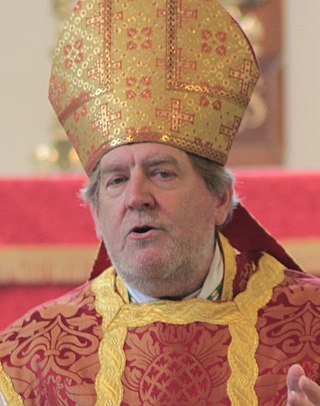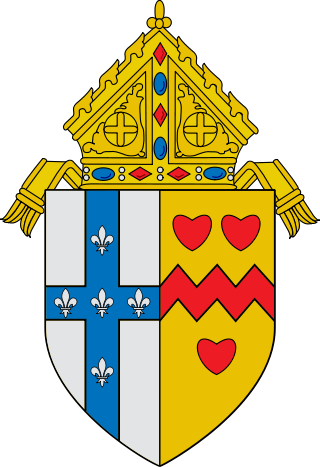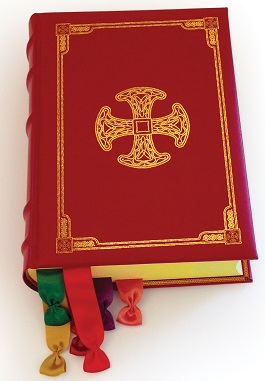
The Anglican Use, also known as Divine Worship, is a use of the Roman Rite celebrated by the personal ordinariates, originally created for former Anglicans who converted to Catholicism while wishing to maintain "aspects of the Anglican patrimony that are of particular value" and includes former Methodist converts to Catholicism who wish to retain aspects of Anglican and Methodist heritage, liturgy, and tradition. Its most common occurrence is within parishes of the personal ordinariates which were erected in 2009. Upon the promulgation of Divine Worship: The Missal, the term "Anglican Use" was replaced by "Divine Worship" in the liturgical books and complementary norms, though "Anglican Use" is still used to describe these liturgies as they existed from the papacy of John Paul II to present.

Vincent Gerard Nichols is a British cardinal of the Roman Catholic Church, Archbishop of Westminster and President of the Catholic Bishops' Conference of England and Wales. He previously served as Archbishop of Birmingham from 2000 to 2009. He was created cardinal in 22 February 2014.
Anglican Papalism, also referred to as Anglo-Papalism, is a subset of Anglo-Catholicism with adherents manifesting a particularly high degree of influence from, and even identification with, the Roman Catholic Church. This position has historically been referred to as Anglican Papalism; the term Anglo-Papalism is an American neologism and it seems not to have appeared in print prior to the 1990s. Anglican Papalists have suggested "that the only way to convert England is by means of an 'English Uniate' rite". Anglican Papalists have historically practiced praying the Dominican rosary, among other Marian devotions, Corpus Christi procession, as well as the reservation of and Benediction of the Blessed Sacrament.

Our Lady of Walsingham is a title of Mary, mother of Jesus venerated by Catholics and High Church Anglicans associated with the Marian apparitions to Richeldis de Faverches, a pious English noblewoman, in 1061 in the village of Walsingham in Norfolk, England. Lady Richeldis had a structure built named "The Holy House" in Walsingham which later became a shrine and place of pilgrimage.

St Etheldreda's Church is a Catholic church in Ely Place, off Charterhouse Street in Holborn, London. The building is one of only two surviving in London from the reign of Edward I, and dates from between 1250 and 1290. It is dedicated to Æthelthryth, or Etheldreda, the Anglo-Saxon saint who founded the monastery at Ely in 673. It was the chapel of the London residence of the Bishops of Ely.

Andrew Burnham is an English priest of the Roman Catholic Church. Burnham was formerly a bishop of the Church of England and served as the third Bishop of Ebbsfleet, a provincial episcopal visitor in the Province of Canterbury from 2000 to 2010. He resigned in order to be received into the Roman Catholic Church. He was ordained as a Roman Catholic priest for the Personal Ordinariate of Our Lady of Walsingham on 15 January 2011.

Keith Newton is an English priest and prelate of the Roman Catholic Church. Newton was named as the first ordinary of the Personal Ordinariate of Our Lady of Walsingham from 15 January 2011 to 29 April 2024, however he is not a Catholic bishop. Prior to his reception into the Catholic Church in 2011, Newton had been a priest and bishop of the Church of England; his last Anglican office was as Bishop of Richborough in the Province of Canterbury from 2002 to 31 December 2010.
A personal ordinariate for former Anglicans, shortened as personal ordinariate or Anglican ordinariate, is a canonical structure within the Catholic Church established in order to enable "groups of Anglicans" and Methodists to join the Catholic Church while preserving elements of their liturgical and spiritual patrimony.

The Personal Ordinariate of Our Lady of Walsingham in England and Wales is a personal ordinariate in the Latin Church of the Catholic Church immediately exempt, being directly subject to the Holy See. It is within the territory of the Catholic Bishops' Conference of England and Wales, of which its ordinary is a member, and also encompasses Scotland. It was established on 15 January 2011 for groups of former Anglicans in England and Wales in accordance with the apostolic constitution Anglicanorum coetibus of Pope Benedict XVI, which was supplemented with the Complementary Norms of Pope Francis in 2013.
Leonard Albert Black is a Roman Catholic priest in Scotland and part of the Personal Ordinariate of Our Lady of Walsingham. He was formerly an Anglican priest in the Scottish Episcopal Church.

The Personal Ordinariate of the Chair of Saint Peter is a Latin Church ecclesiastical jurisdiction or personal ordinariate of the Catholic Church for Anglican converts in the United States and Canada. It allows these parishioners to maintain elements of Anglican liturgy and tradition in their services. The ordinariate was established by the Vatican in 2012.

Our Lady of Victories, in Kensington, London, is a Roman Catholic church. The original church opened in 1869, and for 34 years to 1903 served as pro-cathedral of the Archdiocese of Westminster. That building was destroyed by bombing in 1940: its successor, which survives, opened in 1959. The church stands at 235a Kensington High Street, Kensington, in the Royal Borough of Kensington and Chelsea.

The Church of the Immaculate Conception, Farm Street, also known as Farm Street Church, is a Catholic parish church run by the Society of Jesus in Mayfair, Central London, England.

St James' Church is a large English Gothic Catholic church in George Street, Marylebone, London. Although currently situated in George Street, the church maintains its connection with Spanish Place, the road opposite the current church, because of its historic connection with the Spanish Embassy. It is a Grade II* listed building.

Divine Worship: The Missal (DW:TM) is the liturgical book containing the instructions and texts for the celebration of Mass by the former Anglicans within the Catholic Church in the three personal ordinariates of Great Britain, United States and Canada, and Australia. The rite contained in this missal is the Anglican Use, a liturgical use of the Roman Rite Mass with elements of Anglican worship. It was approved for use beginning on the first Sunday of Advent, November 29, 2015.

Corpus Christi Roman Catholic Church, Maiden Lane, is a Roman Catholic church in Maiden Lane, Covent Garden, in the Westminster City Council area of London, England. The church building, in Early English Gothic style, is grade II listed and was designed by F. H. Pownall; it was “specifically devoted to the adoration of the Blessed Sacrament.”

St Anselm's Church is a Catholic church which is part of the Personal Ordinariate of Our Lady of Walsingham in Pembury, Kent, England. It was originally founded in the 1960s as a chapel-of-ease later serving as a mass centre before becoming its own quasi-parish within the personal ordinariate in 2011, following a conversion of a large number of Anglicans in Royal Tunbridge Wells.

David Arthur Waller is an English Bishop of the Roman Catholic Church. Since 2024, Waller has been the ordinary of the Personal Ordinariate of Our Lady of Walsingham. He was formerly a priest in the Church of England before converting to Catholicism in 2011. As he is celibate, he was eligible to be consecrated as a Catholic bishop unlike his predecessor as ordinary.




















